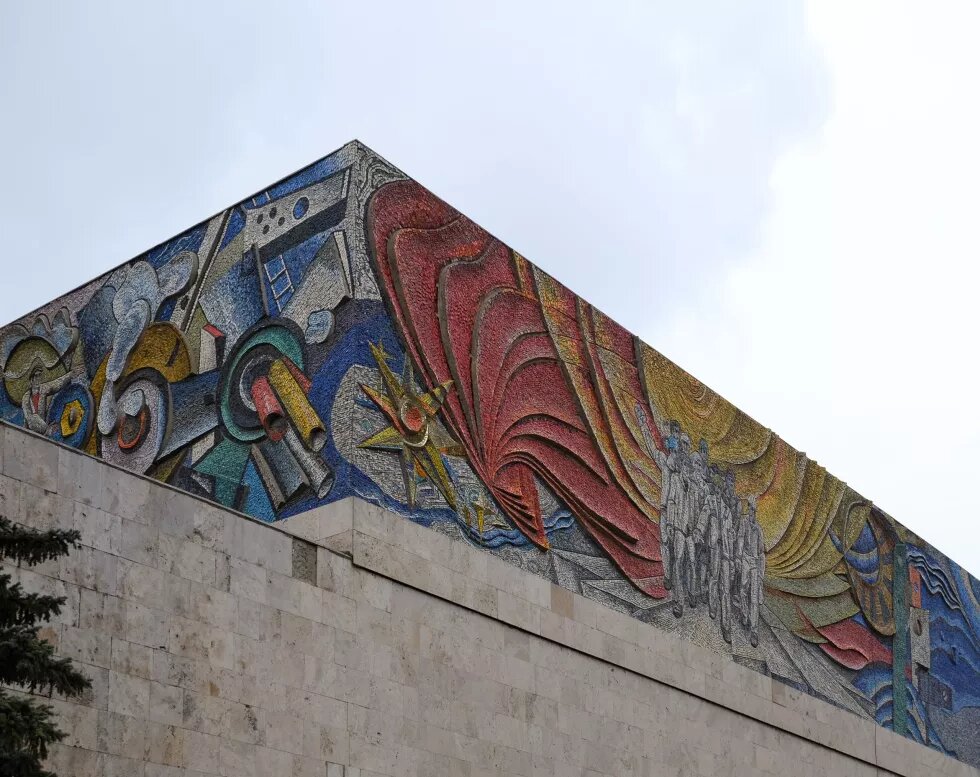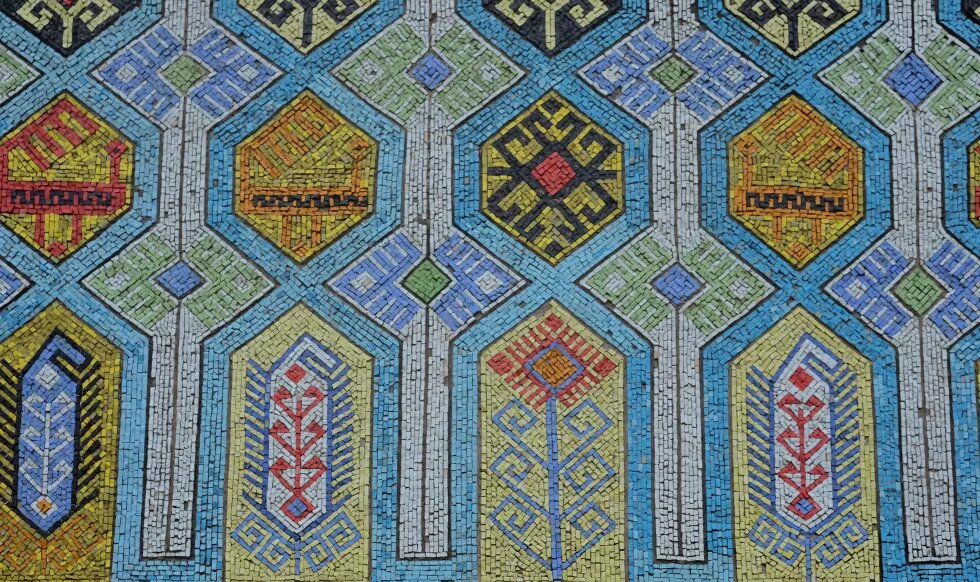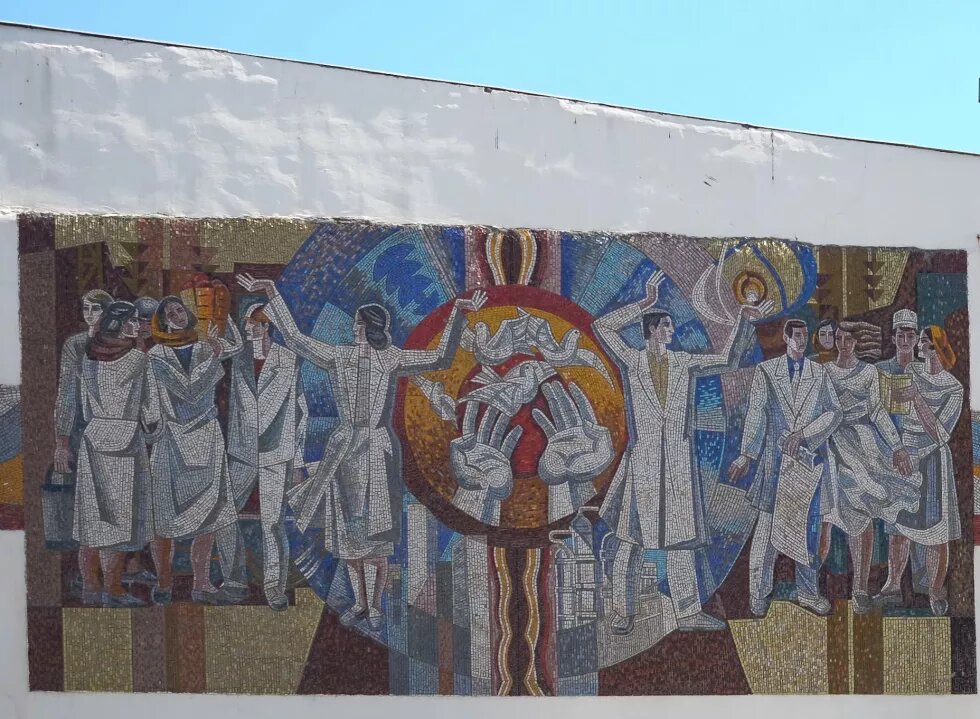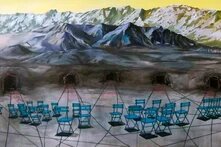
The article sheds light upon the cultural heritage left behind by mosaic artists of Soviet Azerbaijan. With a number of prominent samples destroyed due to “decommunization” of the late 1990s and early 2000s, it is still possible to come across colorful mosaic panels across the whole country. In this study, the authors focus on the existing Soviet mosaics in Baku and briefly discuss some works that did not stand the test of time.
The article was first published in Azerbaijanian language by the online magazine Agora.

The history of mosaic art dates back to antiquity, reaching its prominence at the times of Mesopotamian city-states, Ancient Greece, Rome, and Byzantine. Mosaic, along with other monumental styles, was mainly aimed at the masses: ancient rulers commissioned magnificent mosaic panels to decorate palaces, temples, churches, plazas, and other public domains to glorify themselves, the existing social values, spiritual beliefs, and unanimous principles of the time. Another socio-political realm where mosaic art was utilized for communicating the vision of the ruling regime to the population was the Soviet Union. The role of public art in education and socialist propaganda was acknowledged by Lenin, who, in his letter to Anatoly Lunacharsky – the Soviet Education Commissar, shared the vision of the utopian society depicted in “The City of the Sun” by Tommaso Campanella, where public art served the function of upbringing of new generations[1].
Today, mosaics of Soviet propaganda can be found in nearly all former Soviet states. Our article sheds light upon the cultural heritage left behind by mosaic artists of Soviet Azerbaijan. With a number of prominent samples destroyed due to “decommunization” in the late 1990s and early 2000s, it is still possible to come across colorful mosaic panels across the whole country. In this study, we focus on the existing Soviet mosaics in Baku and briefly discuss some works that did not stand the test of time.
Peculiarities of monumental-decorative art
Mosaic, alongside graffito, painting, fresco, graphic art, sculpture, and architecture, is considered a variety of monumental-decorative art that serves several specific functions. These functions are narrowed down to four major ones that apply to the Soviet tradition. First, mosaic is realized in synthesis with the architecture or natural environment and is used to embody great social ideas (Dichenskaya, 2019). Second, it promotes the current political system and glorifies the path to a bright future (Rozhdestvenskaya & Medvedeva, 2018). Thirdly, the anthropogenic environment created by the mosaic stands out for its sublimity while mobilizing people around uniform responses and unanimity (Ibid.). This is why mosaics are usually found in large squares, public spaces, and other gathering points. And the fourth function is establishing “soft contact” with the population, creating public values and a unified ethic (Ibid.).
An unexpected result of the reforms
After Stalin's death, the newly elected First Secretary of the Communist Party, Nikita Khrushchev, quickly ended many political and economic decisions typical of Stalin's era. This new political course dictated by Khrushchev was also reflected in the revived architecture, urban planning, and urbanization policies of the USSR. Thus, in 1955, the decree “On the abolition of additions in construction and design” was signed. This document opened a new page in the USSR's construction and architecture history (Kadyrova, 1987). The main principle of the decree was doing away with the expensive decor used in Stalin's era to decorate the newly built institutional and residential buildings (the style known as “Stalinist Empire” today). In addition, the 1957 decree “On the development of housing construction in the USSR” aimed to ensure the mass construction of typological residential buildings that would cost less and provide each family with a private apartment (Bylinkin & Ryabushin, 1985). It was these two decisions that changed the face of Soviet cities forever: the micro districts that are familiar to most of the post-Soviet people (and where some of us still live today) began to emerge. These buildings were built from concrete panels made in factories and brought to the construction site in a ready-to-assemble form, making the construction process cheap and fast.
Although these decisions of the Khrushchev government stood up to the task of providing low-cost housing at record speeds, some unexpected problems began to emerge over time. The simplified structure and appearance of typological micro-districts soon disappointed the public: complaints began to arise that social and household needs needed to be met better and that the new housing estates were aesthetically monotonous and boring. Most of the buildings looked like rectangular boxes, so there was a call to decorate the building facades[2]. Since the beginning of the 1960s, the facades of typological residential buildings had been decorated in the USSR, with the country's leading art and architecture institutes and specialists involved in the work. Mosaic, sgraffito, painting, and relief arts were used to overcome the monotony[3] of the newly built districts and to restore the emotional ties between the local population and their living environment.
"National in form, socialist in content"
From the end of the 1950s, the establishment of typological housing estates all across the USSR led to the growth of urban areas and the emergence of new sub-centers. This factor had to work for the benefit of propaganda, a primary goal of monumental-decorative art of the time. For this reason, another vital feature of mosaics created in this period was that they were integrated in the newly designed public spaces in the centers of cities and the newly built outskirts[4]. This way, the state aimed to transfer its ideas and values to the population both in the center of the cities and in remote areas.
Unlike the early years of the Soviet state, the approach to monumental-decorative art in the 1960s and beyond was greatly nationalistic, and the central government supported the use of local history, folklore, and ethnic elements in architecture. However, the national character of decorative art had to carry socialist content and convey the ideological values of the central government to the local population (Dremaite, 2017). This doctrine served the presentation of nationality from the lens of socialism and the formation of the national spirit in the context of socialism. Among the mosaics created in 1960-1980, one can see national dances, people celebrating Soviet holidays in national costumes, plots from national fairy tales and literature, references to national history, etc. At the same time, as in previous years, the depiction of the heroes of the current era was still among the main functions of this period’s mosaic panels. The heroes of the day’s socialist reality were shown working for a “bright communist future," regardless of national identity. These images included the image of the “liberated human”[5] (an emphasized feature of the post-Stalin era), athletes, cosmonauts, educators, manual laborers of various industries, scientists, etc. (Pronina, 1976).
The development of mosaic art in Soviet Azerbaijan. An overview of some great examples
The development of mosaic art in Soviet Azerbaijan began in the second half of the 20th century, mainly in the 1960s. It was the result of the specialized education in monumental art that young local personnel received in the central cities of the USSR after the Second World War. While wall paintings in some parts of Azerbaijan were quite common by that time, the number of works made in other styles, including mosaic and sgraffito, was insignificant. In the second half of the century, Azerbaijani monumental artists created many beautiful and eye-catching mosaic panels. Among the authors of these works are Ogtay Shikhaliyev, Mikayil Abdullayev, Sirus Mirzazadeh, Elmaz Huseynov, Arif Azizov, Arif Alasgarov, Arif Agamalov, Tofig Agababayev, Huseyn Hagverdiyev, Hajibala Rajabov, Huseynaga Huseynov, Rashid Heydarzadeh, Mirzaaga Gafarov, Rasim Khalafov, Yagub Mehdiyev, Rahim Mammadov, Shamil Buksayev, Hasanaga Alasgarov, Ahmed Ahmadov, Fikret Ibrahimov, and others. Some of the works created by these artists still decorate the streets and public spaces in Azerbaijan with their unique appearance, while others are disappearing.
The artistic and stylistic feature of the Azerbaijani mosaics is recognized in the brightness of colors and the original plot lines built on oriental motifs, literature, folklore, and local culture. One of the most famous figures of the Soviet mosaic art of Azerbaijan is Ogtay Shikhaliyev. Some of his mosaic panels still decorate the interiors and exteriors of several buildings. One of the better remembered images produced by the artist was the hardworking person[6] - the naturalistic portrait was to serve as inspiration for future generations. Among some of the still existing mosaic panels, we can distinguish “Lenin and workers” (1969) in the Binagadi district of Baku, created jointly with Buksayev and H. Rajabov; the mosaic layout of the locomotive depot of the Azerbaijan Railway Bilajari station (1969); the mosaic panel on the façade of the Baku Household Air Conditioners Factory (1975), designed together with H. Rajabov, symbolizing the unity of labor with scientific and technical progress; the artistic design of the Baku Shoe Factory (1980) designed together with H. Rajabov; the “Rainbow” decorating the facade of the Baku Deep Sole Factory (1987) and others.
One of Shikhaliyev's masterpieces is the large mosaic panel called “The Press” (1977), prepared in collaboration with Rajabov on the front entrance of Azerbaijan Publishing House. This mosaic panel in the form of an open book greets visitors of the building with various symbols representing different eras in the history of writing - from hieroglyphs to modern printing style[7]. The artist's other mosaic masterpiece is “Tales of Azerbaijan” (1977 - 1990), located on the second floor of the Sports-Concert Complex named after Heydar Aliyev. This mosaic consists of several interconnected mosaic panels reflecting folk traditions and tales, abstract compositions, elements of state attributes, and other details[8].
Another prominent figure of Azerbaijani mosaic art is Sirus Mirzazade. The artist’s most famous and memorable mosaic panel is “The Happiness” (1975), which decorates the wall opposite Saadat Palace (The Palace of Happiness) to this day. Once a mansion of a famous oil baron Murtuza Mukhtarov, today the building operates as the main marriage registry in Baku. “The Happiness” attracts attention due to its colors and the relief technique used in its layout. In addition, this mosaic panel demonstrates folk musical instruments like tar, kamancha, zurna, and drum, which are important symbols of the Azerbaijani national wedding tradition. Another famous relief mosaic by Mizazade is “Worker's Hands” (1978), which he designed with Rashid Heydarzade and Arif Alasgarov. The mentioned mosaic composition was made in honor of oil workers and is located at the so-called “20th Area” settlement, known for the centuries-old oil fields in its vicinity.
Nizami metro station is among the most popular public spaces in Baku, known for its Soviet mosaic design. The 19 mosaic panels decorating this interior were created by Mikayil Abdullayev (1976). One of those is a large portrait of the 12th-century poet Nizami Ganjavi[9]. At the same time, the other 18 works are the plots and protagonists from the poet's “Khamsa” – a collection of the five great poems (The Treasury or Storehouse of Mysteries, Khosrow and Shirin, Layla and Majnun, The Book of Alexander and The Seven Beauties). Therefore, the 18 mosaic panels that form the basis of the artistic composition are placed in the sequence according to the content of “Khamsa” motifs
The lost legacy
In 2001, the Cabinet of Ministers compiled a list of monuments protected by the state which excluded the buildings, structures, and monuments related to communist ideology. Most likely, due to this decision, some of the mosaics were destroyed, while others were completely forgotten and neglected. Cultural decommunization is a common feature in the transitional stages of most post-Soviet countries. However, it led to the erasure of several important works created by Azerbaijani architects and artists during the Soviet period. Is it fair to define the destruction of Soviet Azerbaijani art as “decommunization”? In addition, an important point specific to the post-Soviet countries is that some monumental-decorative art works were demolished or are getting demolished by the new owners of the buildings, who purchased them during post-Soviet privatization. Cities grow, tastes change, and the elements that do not meet the new trends and development goals are mercilessly removed from the city's historical context.
Among the destroyed mosaic panels, we can mention the one designed by Elmaz Huseynov (1972) that once decorated the facade of the Baku Slavic University, presenting great Azerbaijani thinkers; “Volcano” (1984) by Yagub Mehdiyev and Huseyn Hagverdiyev, which once decorated the building of the Ministry of Ecology and Natural Resources; Tofig Agababayev's “Spring” (the 1970s); Ogtay Shikhaliyev's decoration of the former Garabagh (Tourist) hotel (1973); Ogtay Shikhaliyev and Hajibala Rajabov’s “Toward the Stars” (1968) that once decorated the facade of school number 18and others[10].
Concluding Remarks
Today, there is a need for the state’s attention to the preservation of monumental-decorative art of Soviet Azerbaijan. These works are not only the symbols of the Soviet system that symbolize the relatively recent past of our history, but they present an important legacy that Azerbaijani artists have left behind. This heritage should be considered an integral part of the country's history, preserved in the city's historical memory, and passed down to future generations. Unfortunately, today the country's population has minimal knowledge of Soviet mosaics, and some works urgently need professional attention and restoration.
References
Dremaite, M. (2017). Baltic modernism: Architecture and housing in Soviet Lithuania. Dom Publishers.
Khalid, A. (2021). 18 Soviet in form, national in content? Central Asia, 331–355. https://doi.org/10.1515/9780691220437-024
Petrova, A., & Hill, J. (2021). Монументальная мозаика Москвы: Между Утопией и Пропагандой, 1926-1991. [Monumental mosaic of Moscow: Between Utopia and Propaganda, 1926-1991.] Bombora.
Bylinkin, N. P., Ryabushin, A. V. (1985). Современная Советская Архитектура: 1955-1980 гг. [Modern Soviet Architecture: 1955-1980] Стройиздат.
Dichenskaya, Y. А. (2019). Роль мозаичного искусства советского периода в организации современной архитектурно-пространственной среды города (на примере мозаичного триптиха «Земля» в г. Бресте) [The role of mosaic art of the Soviet period in the organization of the modern architectural and spatial environment of the city (on the example of the mosaic triptych "Earth" in Brest)], 81–86.
Kadyrova Т. F. (1987). Архитектура Советского Узбекистана. [Architecture of Soviet Uzbekistan] Стройиздат.
Pronina, I. (1976). Советское Монументальное Искусство: История, Актуальность. [Soviet Monumental Art: History, Relevance].
Rozhdestvenskaya, Y. S., Medvedeva, A. В. (2018). ВИЗУАЛЬНО-ЭСТЕТИЧЕСКИЕ ХАРАКТЕРИСТИКИ МОЗАИКИ СОВЕТСКОГО ПЕРИОДА 60-80-Х ГГ. ХХ В. ТРАДИЦИИ И ИННОВАЦИИ В СТРОИТЕЛЬСТВЕ И АРХИТЕКТУРЕ. [VISUAL-AESTHETIC CHARACTERISTICS OF MOSAICS OF THE SOVIET PERIOD BETWEEN 1960 - 1980. TRADITIONS AND INNOVATIONS IN CONSTRUCTION AND ARCHITECTURE] ГРАДОСТРОИТЕЛЬСТВО, 397–400.
[1] Short, E. (2018, January 23). Activists fight to save Ukraine’s Soviet-era mosaics. The Odessa Review. https://odessareview.com/activists-fight-save-ukraines-soviet-era-mosaics/
[2] Novikova, А. (7 September, 2017). Прометей и времена года: о чем рассказывают советские мозаики Екатеринбурга. Мозаичные панно на жилых домах и дворцах культуры в выставке «Вечное лето». [Prometheus and the seasons of the year: what do the Soviet mosaics of Yekaterinburg tell? Mosaic panels on residential houses and palaces of culture in the "Eternal Summer" exhibition.] Retrieved January 10, 2023, from https://www.the-village.ru/weekend/the-village-guide/282120-soviet-mosaic?from=infinite_scroll
[3] Ibid.
[4] Ibid.
[5] Ibid.
[6] Baku City Main Department of Culture. (3 September, 2020). Bu Gün Xalq Rəssamı Oqtay Şıxəliyevin Doğum Günüdür. [Today is The Birthday of the People’s Artist Ogtay Shikhaliyev] http://az.baku-art.com/az/bu-gun-xalq-ressami-oqtay-sh-xeliyevin-dogum-g-n-d-r
[7] Aliyev, Z. (n.d.). Mozaik Pannoların Estetikası. Mədəniyyət. [Aesthetics of Mosaic Panels. Culture.] https://www.medeniyyet.az/page/news/61652/Mozaik-pannolarin-estetikasi.html
[8] Shukurov, V. (2022). Мега-мозаика советского Баку, которая была самой большой во всем СССР (ФОТО). [Mega-mosaic of Soviet Baku, which was the largest in the entire USSR (PHOTO)] Azerhistory. https://azerhistory.com/?p=50656
[9] Nizami Ganjavi is among the most influential personalities in Islamic literature, comprising the bedrock of Azerbaijani cultural identity. People in the country feel proud that the author of the globally known “Khamsa” was born and lived in Ganja – the second largest city in Azerbaijan.
[10] Mamedova, А. (13 February, 2022). Советская мозаика Баку: наследие, уходящее в историю. [Soviet Mosaic of Baku: A Legacy Going down in History.] Dalma News. https://dalma.news/ru/sovetskaya-mozaika-baku-nasledie-uhodyashchee-v-istoriyu/





